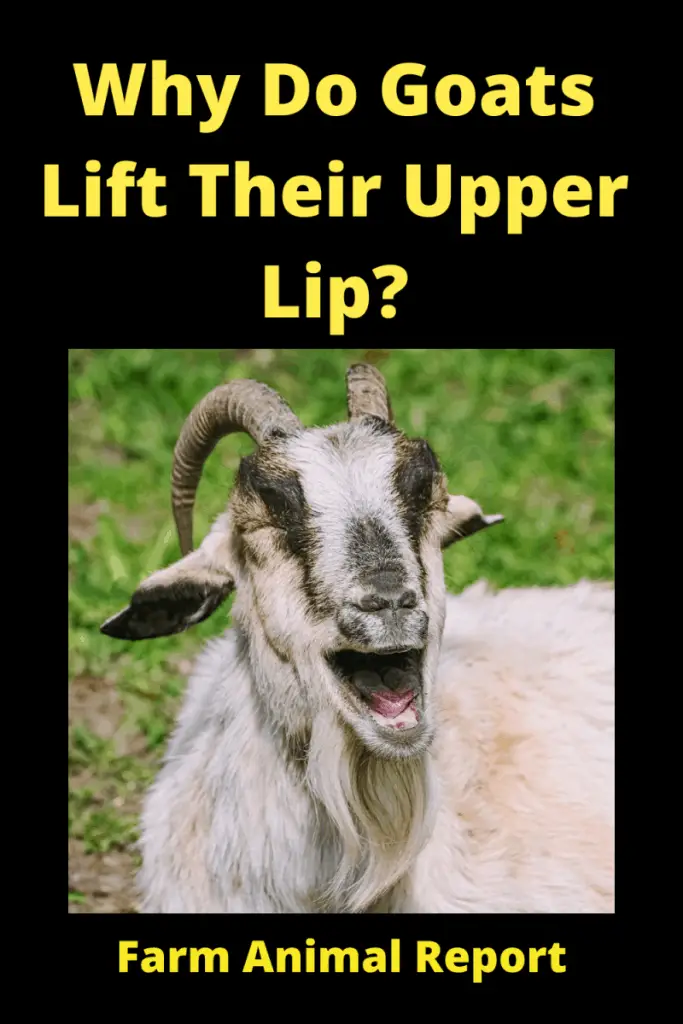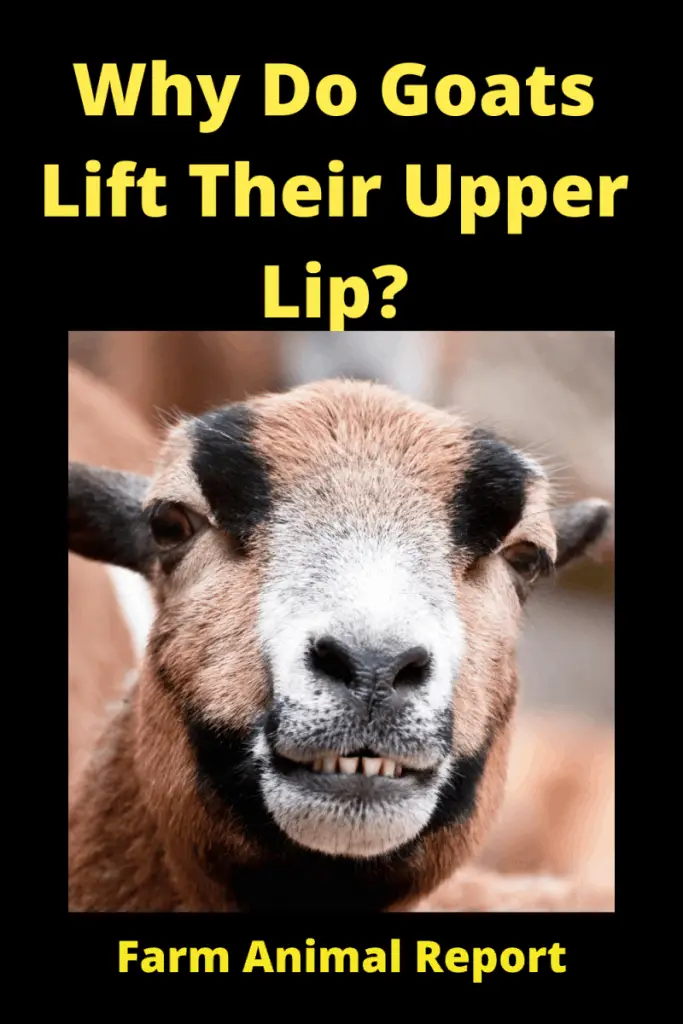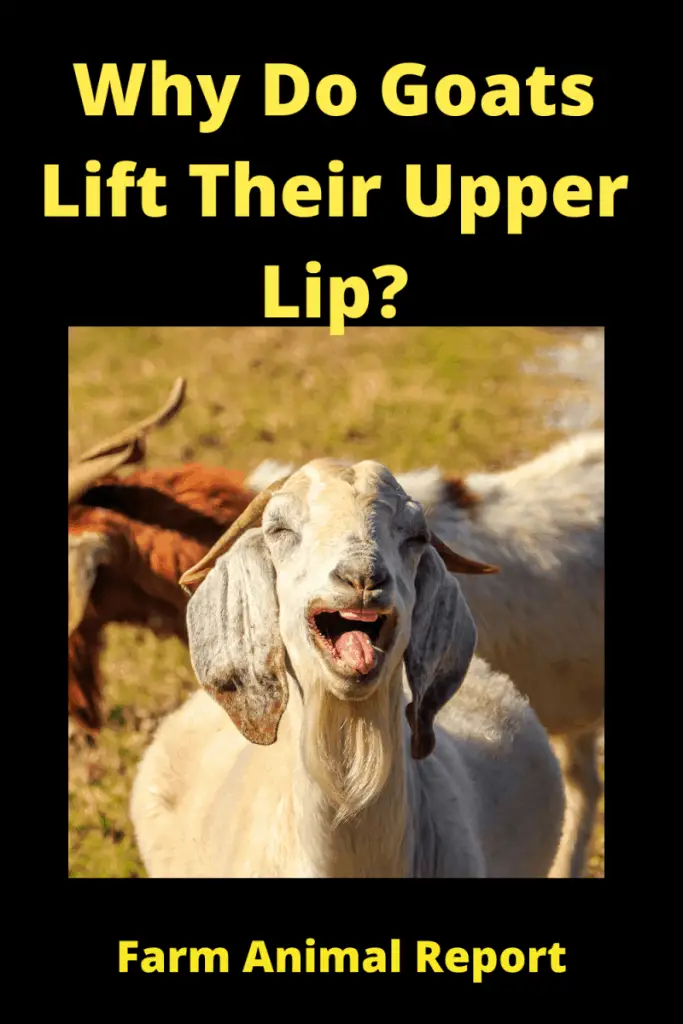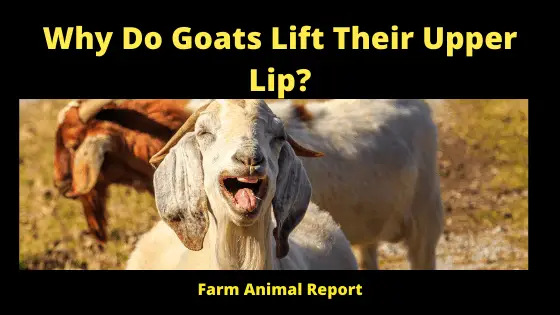Why Do Goats Curl Their Lip?
Why do Goats Lift their Upper Lip – By curling their upper lips, many kinds of mammals expose their vomeronasal organ in the roofs of their mouths and draw scent towards it. This behavior helps them identify what they smell, especially the scent of animals they do not know and sexy scents, like females in heat. Lifting of the upper lip is referred to as a response called the Flehmen response.
Flehmen Response
Flehmeningis from a German word meaning to curl the upper lip. Flehmen response is also called Flehmen position, Flehmen Reaction, Flehming or Flehmening.
“it is a behavior in which an animal curls back its upper lip exposing its front teeth, inhales with nostrils usually closed, and often holds this position for several seconds. It may be performed over a sight or substance of particular interest to the animal, or maybe performed with neck stretched and the head held high in the air”. Why Do Goats Curl Their Lip
See Amazons Resources on the Science of Raising Goats
Flehmen is performed by a wide range of animals, including ungulates and felids. The behavior facilitates the transfer of pheromones and other scents into the vomeronasal organs located above the roof of the mouth via a duct that exits just behind the front teeth of the animal.

First Discovered
The flehmen’s response was first discovered by Fredrick Ruysch and described by Ludwig Jacobson.
Description
This process is characterized by the animal curling back its top lip exposing the front teeth and gums, then inhaling and holding the posture for several seconds.
The behavior may be performed over particular locations, in which case the animal may also lick the site of interest or perform the flehmen with the neck stretched and head held high in the air for a more general gustatory or taste-related investigation.
The flehmen response often gives the appearance that the animal is looking spiteful, grimacing, smirking, or laughing.
Mechanism
The flehmen response draws air into the VNO, an auxiliary olfactory sense organ found in many animals. This organ plays a role in the perception of certain scents and pheromones. The vomeronasal organ is named for its closeness to the vomer and nasal bones and is particularly well developed in animals such as cats and horses. The VNO is found at the base of the nasal cavity. It is encompassed inside a bony or cartilaginous capsule that opens into the base of the nasal cavity. Animals that exhibit flehmen have a papilla located behind the incisors and ducts, which connects the oral cavity to the VNO, with horses being an exception. Horses exhibit flehmen but do not have an incisive duct communication between the nasal and oral cavity because they do not breathe through their mouths; instead, their VNOs connect to the nasal passage by the nasopalatine duct.

Chemical Cues
The chemical cue obtained by an animal exhibiting the flehmen response is the non-volatile organic compound. In contrast to volatile organic compounds, no-organic compounds are those carbon compounds that do not participate in atmospheric photochemical reactions or evaporate under normal atmospheric conditions. The VNO detects non-volatile compounds, which must have direct contact with the odor source. Sources of non-volatile compounds relevant to the flehmen response include pheromones and hormones excreted from the genital organs and urine.
Function
An animal may perform the flehmen response when investigating particular interest sites or perhaps odors or tastes.
See Our Guide – 8 Ways to Make Money from Goat Farming
Intraspecies Communication
The function of the flehmen response is intra-specie communication. By transferring air containing pheromones and other scents to the VNO, and the olfactory chemosensory organ located between the roof of the mouth and the palate, animals, can gather chemical messages. These scents tell an animal about other members of their species in some of the following ways
Identifying Reproductive Status
Male individuals commonly use flehmen response as an olfactory mechanism for identifying the reproductive state of the females of the same species based on pheromones in the female’s urine or genital tract. This is exhibited in the reproductive behavior of the sheep. The ram often exhibits the flehmen response after sniffing the ewes, external genital region, but this occurs more frequently on the day before estrus when the ewes are sexually receptive.
Reproductive Synchrony
Flehmen also plays a role in reproductive synchrony in females. In the sable antelope, the frequency of flehmen changed seasonally, with the highest levels before conception. Femal antelopes associate closely with other females in the same reproductive tract. Flehmen rates between females anticipated birth synchrony. Additionally, the level of synchrony was predicted by the frequency of female urine sampling during the previous year. Flehmen is a mechanism used by female sable antelopes to manipulate the timing of both the conception and birth of the offspring. In the bison, flehmen behavior in females has also been shown to stimulate the onset of estrus and copulation synchronization.
Post Parturition
In horses, mares commonly show a peak in flehmen’s response during the first few hours after giving birth. Smelling the newborn foal and amniotic fluids associated with the birth often produces the reaction.
Immature Animals
In young horses, both colts and fillies exhibit flehmen behavior toward other conspecifics with neither sex performing the behavior more than the other. However, it has been reported that young colts flehmen up to five times more frequently than the fillies, and fillies flehmen more frequently than mature mares. Young elephants also have a flehmen response to stimulants. The VNO of newborn elephant displays a structural maturity similar to adults, which supports the conclusion that flehmen at only six weeks of age is used to deliver chemical pheromones to a functional VNO.

Interspecies Communication
The flehmen response is not limited to intra-specie communication. Goats have tested for their flehmen response to urine for twenty different species, including several non-mammalian species. There is a common element in the urine of all species, an interspecific pheromone, which elicits flehmen behavior as suggested by the study. Specifically, the chemical pheromones level of a modified form of androgen, a sex hormone, was associated with the response in goats.
Mammals Exhibiting the Flehmen Response
A wide range of mammals exhibit flehmen response, including both predatory and non-predatory species.
The response is perhaps most easily observed in domestic cats and horses; both exhibit a strong flehmen response to odors. Stallions usually smell the urine of the mares in estrus, whereas the male giraffe’s flehmen response includes tasting the female’s urine. Elephants perform the flehmen response bit and also transfer the chemosensory stimuli to the vomeronasal opening in the roof of their mouths using the prehensile structure, sometimes called a finger at the tips of their trunks.
Other Animals Exhibiting Flehmen Response
Other animals included in the list of exhibiting the flehmen response include American buffalo, tigers, tapirs, lions, giraffes, goats, kobs, hedgehogs, rhinoceros, and giant pandas, antelopes, and hippopotamuses.
Goat behavior
The information provided below is about the general behavior of the goats. Goats are friendly, smart, and interesting creatures, and you must know if you are deciding to keep the goats.
Flehmen Behavior / Jacobson’s Organ
This response is evident when goats curl their upper lip, stretch their neck, and look like he is sniffing the air with their lips. Both male and female goats of any age can exhibit this behavior. Many other animals exhibit the flehmen response, including horses, giraffes, donkeys, cats, yak, cows, sheep, and even rhinos.
The response is triggered when goats smell something and must investigate further. Goats, and all animals who show flehmen have an olfactory sensory organ on the roof of their mouths, called the Jacobson’s organ, where they can smell and sense pheromone. The reason for the flehmen response is simply self-communication. Goats will use flehmen when they smell something they are interested in and use it to gather information about the smell. Urine, feces, and birthing fluids are often investigated in the flehmen and doe’s hind end to check for the estrus stage. The result of that investigation provides a goat with the answer to “what is that smell?”
Other interesting Goat Behaviors
Pawing the Ground
Yes, it is true goats do not have paws. Pawing the ground is being used as aa verb. There are mainly three reasons that goats will paw the ground.
1. To Get your Attention.
Goats, especially spoiled babies, or adults that were spoiled babies, will paw your leg to get your attention. Most often, this behavior is accompanied by nibbling on your clothes or your fingers. This generally means “treat please” or” pet me.”
2. Hormones
Bucks will paw the ground in frustration when they cannot get to a doe through the fence. This is generally accompanied by blabbering of the lips and tongue and lots of vocalizations. You will see a buck paw and kick out their legs as a part of their pre-mating activity. Does in heat will some time paw the ground as well, and act “bucky.” Does in labor will paw the ground as they prepare for kidding.
3. To Fluff the Bed
It does not matter if the goat is getting ready to lie in the grass, on a shelf, in the dirt, or the fluffy bedding. Goats often paw their sleeping area before they lay down. Most likely, this is an instinct that was ingrained in them thousands of years ago. Perhaps they are digging down to get to the cool sand.
4. Climbing and Playing
Goats are naturally curious, and goats of all ages love to climb. Stools, stumps barrels, shelves, and pallets of many levels should be provided in all yards of a goat. Little slides, cubes, houses, and tables should be there for goats to explore. It is important to provide plenty of options for goats so that they do not get bored, and also goat will choose to nap on a raised shelf or platform over the ground every time.
Babies are so energetic, and they bounce and jump and run all around all the time. If a particularly happy mood strikes the herd, you might see old and young alike bounce down the hill to the pasture, kicking their feet out from side to side and hopping. It is about just the best feeling in the world to know your goats are happy and healthy.
5. Headbutting
Goats head butt to display dominance over other goats. The process of gaining a position in a herd is incredibly interesting.
Inside every herd, whether you have two goats or a hundred, there is a hierarchy or official status for every goat. The goats only truly know the status, but humans can observe and note it if they watch long enough.
6. Intelligence
Goats are extremely intelligent and also extremely motivated by food. That being said, you can teach a lot of tricks and commands and get an appropriate response. Researches taught the goats for solving the puzzles and got amazing results. They repeated the same puzzle to goats ten months later, and they did even better. They also have incredible memories.
7. Response to Names
You can also teach goats their names and respond to simple commands like “get up,” lay down,” and come. When milking is done, it is done in the same order every day. Their motivation is food. They must be allowed freely to eat as much grain as possible during milking.
8. Drinking Buckets Colors
At some farms, goats were adapted to drink more water from a yellow bucket. Their favorite colors are yellow, and they prefer to drink in yellow buckets.
Goats rarely pass gas out the back end, but they often burp, especially when they are chewing their cud.
Goats sneeze when they sense danger to alert other members of the herd.
Some breeders have done semi-successfully the potty training of goats. It is not much hard to train a goat to pee in a certain spot. But high doubts are there to train them to poop in a certain area. Poop seems to fall at most inappropriate times wherever the goat is.
Goat Breeder Associations
| Goat Association | Location | Link |
|---|---|---|
| American Goat Breeders Association | United States | AGF |
| English Goat Breeders Association | UK | EGBA |
| Canadian Meat Goat Association | Canada | CMG |
| Minature Goat Breeders Association | Australia | MGBA |
| Boer Goats | South Africa | BGSA |
| American Boer Goat Association | United States | ABGA |
| World Goat Breeders Associations | List | WGBA |
Goat Breeds
| Goat Breeds | Meat | Dairy | Wool | |
|---|---|---|---|---|
| Boer | Alpine | Angora | ||
| Genemaster | Lamancha | Cashmere | ||
| Kiko | Nigerian Dwarf | Pygora | ||
| Kinder | Nubian | |||
| Myotonic | Oberhasil | |||
| Pygmy | Saaneen | |||
| Savanna | Sable | |||
| Spanish | Toggenburg | |||
| Tennessee Meat Goat | ||||
| TexMaster |


